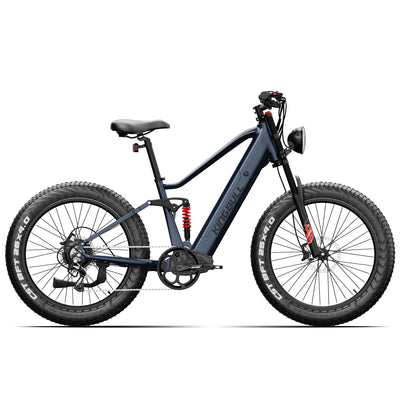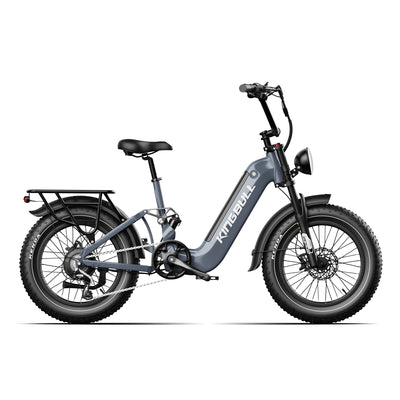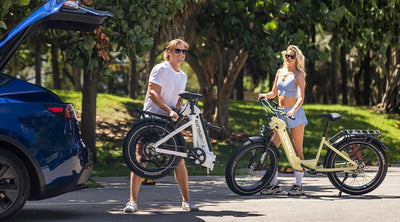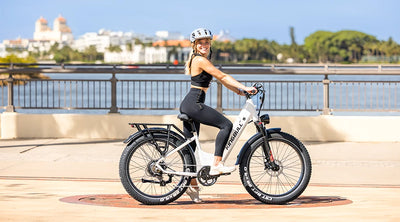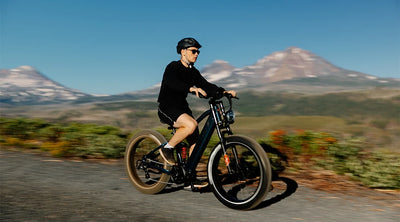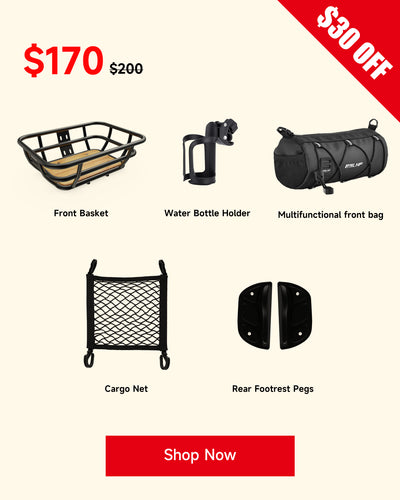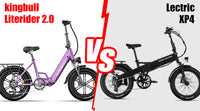Explore News
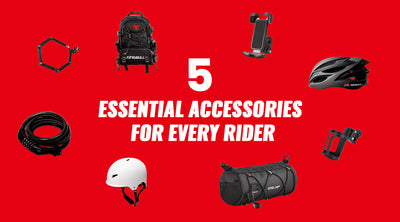
Tips & Cycling Knowledge
Don’t Ride Without These: 5 Essential E-Bike Accessories
Electric bikes are no longer just a commuter tool—they're a movement. Whether you're navigating urban traffic or tackling weekend trails, the "electric assist" transforms the riding experience, offering freedom and efficiency.
But to truly unlock the full potential of your e-bike and ensure every trip is safe, comfortable, and hassle-free, you need more than just a great bike. Serious riders know that the right gear makes all the difference. These five core accessories are the unheralded heroes that solve real-world problems like riding anxiety, safety, and storage.
Ready to upgrade your ride? Here are the five must-have accessories you need in your e-bike cockpit.
1. The Helmet: Your Non-Negotiable Safety Shield
This is non-negotiable. Whether you’re cruising at 15 mph or 28 mph, a helmet is the single most critical piece of safety equipment. Head injuries are the most common and severe result of cycling accidents. A properly fitted helmet significantly reduces impact force and drastically lowers the risk of serious injury.
Proper Fit is Key: Choose a helmet that fits snugly and uses an adjustable dial-fit system to prevent shifting.
Ventilation Matters: Look for designs with ample air vents to keep your head cool, especially during long summer rides.
2. The Water Bottle Cage: Stay Hydrated, Stay Focused
Even with electric assist, e-biking is still physical activity. Staying hydrated is vital for maintaining performance, energy levels, and concentration, particularly on long-distance rides or in hot weather.
A solid bottle cage mounted directly to your frame is a simple game-changer:
Convenience: It allows you to take frequent, small sips without breaking your stride or taking your eyes off the road.
Load Management: Keeps the weight off your back (unlike carrying water in a backpack) and frees up valuable storage space.
Style and Stability: Look for lightweight aluminum or durable composite plastic cages that hold your bottle securely, even over bumps.
3. The Phone Mount: The Command Center on Your Handlebars
Your phone is your navigator, entertainment system, and lifeline. A reliable phone mount secures your device directly to your handlebars, keeping essential information—like turn-by-turn directions, riding metrics, and incoming calls—in clear view.
Rugged Durability: Prioritize mounts with secure, all-weather clamping systems to prevent the phone from dropping due to vibrations or bumps.
Hands-Free Operation: Keep your hands where they belong—on the controls—and avoid the dangerous distraction of fumbling for a phone in a pocket or bag.
Screen Accessibility: Allows you to quickly glance at maps or track your stats without needing to pull over.
4. Smart Storage Solutions: Conquer Your Gear Clutter
From patch kits and rain gear to lunch, you’re going to need storage space. Effective storage is the key to truly 'lightening your load' and ensuring you have everything you need for the journey.
Choose a solution tailored to your ride style:
Front Bag: Perfect for quick access to snacks, wallets, keys, and phones. Look for waterproof materials and quick-release systems.
Rear Frame Bag: Ideal for commuters and tourists. These offer maximum capacity for groceries, work items, or even a change of clothes. Ensure they attach securely to your e-bike’s rack.
Kingbull Ultra-Capacity Backpack: Built for riders who need serious storage without sacrificing style or smarts, this premium backpack combines rugged, lightweight construction with smart features like a built-in USB charging port—plus a fully waterproof design to protect your gear in any weather. Stay organized on the go with multi-compartment storage that fits your laptop, gear, and daily essentials—so you can focus on the ride.
5. The Bike Lock: Essential Peace of Mind
The unfortunate truth of urban cycling is that theft is always a threat. A high-quality bicycle lock is your primary defense and a non-negotiable investment to protect your valuable e-bike. Never rely on the built-in wheel lock alone.
Security Rating: Look for locks with high security ratings and utilize the "two-lock" method to secure both the frame/wheel to an immovable object.
Types to Consider: U-Locks offer great security, while Folding Locks provide a better balance between security and portability/storage convenience.
Portability: Since you’ll carry it daily, choose a lock that is secure but can be easily mounted to your frame without interfering with your ride.
The e-bike lifestyle is about freedom and efficiency. By investing in these five core accessories, you’re not just buying gear—you’re investing in your safety, comfort, and the pure joy of the ride. Don't wait until you're halfway to regret not being prepared. Gear up and enjoy the open road!
Read more
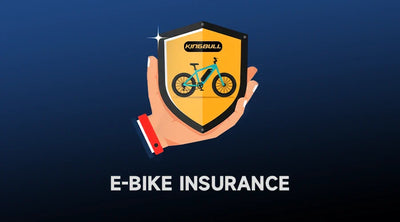
Tips & Cycling Knowledge
Do You Need Insurance for Your E-Bike in the U.S.? A Complete Guide
Electric bikes (e-bikes) are booming in popularity across the U.S. — from daily commuters in big cities to weekend riders exploring trails. But while most people think about range, speed, or motor power when buying an e-bike, one important question often gets overlooked: Do I need insurance for my e-bike?
The answer depends on where you live, how you ride, and the type of e-bike you own. Let’s break it down.
Why Consider Insurance for Your E-Bike?
Theft is common. E-bikes are valuable and attractive to thieves. A stolen e-bike can mean a big financial loss.
Accidents happen. If you accidentally collide with a pedestrian or vehicle, you could face liability costs.
Repairs can be costly. Batteries, motors, and frames aren’t cheap to replace if damaged.
Peace of mind. Insurance can make riding stress-free, especially for daily commuters.
Types of Insurance That May Cover E-Bikes
1. Homeowners or Renters Insurance
Often covers theft of personal property, including e-bikes, if stolen from your home or garage.
Usually does not cover accidents, liability, or damage while riding.
Important: Some policies exclude e-bikes with motors. Always confirm with your insurance provider.
2. Specialized E-Bike Insurance
Providers like Velosurance, Spoke Insurance, or Markel Insurance offer dedicated e-bike coverage. These typically include:
Theft (at home or on the road)
Collision or crash damage
Liability if you injure someone or damage property
Medical payments for injuries
Roadside assistance in some cases
👉 Best for frequent riders, commuters, or anyone with a high-value e-bike.
3. Personal Liability or Umbrella Policies
Protects you if you cause injury or damage while riding.
Often used to supplement other coverage.
4. Health Insurance
Covers your own medical costs if you get hurt in an accident.
Does not cover bike repairs or damage to others.
5. Motorcycle/Moped Insurance (in Some States)
If your e-bike is faster or more powerful (class 3 or modified), your state might classify it as a moped.
In this case, you may be legally required to carry insurance similar to motorcycle coverage.
Which Insurance Is Right for You?
Casual riders with low-speed e-bikes (Class 1 or 2):Homeowners/renters + health insurance may be enough.
Daily commuters or higher-value e-bike owners:Specialized e-bike insurance is worth it.
High-speed e-bike riders (Class 3, 28 mph):Check your state laws — you may need motorcycle-style coverage.
Final Tips Before You Ride
✅ Always lock your e-bike with a high-quality lock — insurance won’t stop theft but can reduce the financial hit.✅ Keep receipts, photos, and serial numbers — this makes claims easier.✅ Check your state’s e-bike classification laws before choosing coverage.
Bottom Line
While not legally required in most states, insurance for your e-bike is a smart investment if you ride frequently, commute daily, or own a higher-value model. The right policy can protect you from theft, costly repairs, and liability — giving you confidence every time you hit the road.
Read more
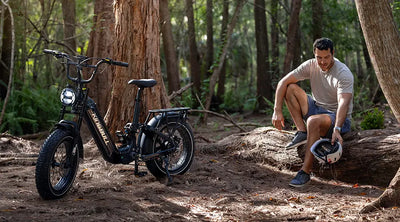
Tips & Cycling Knowledge
E-Bike Camping Guide: Your Green Outdoor Adventure Awaits
Summer breeze gently blowing, sunshine just right – perfect weather for a spontaneous camping trip! If you're considering embarking on a green outdoor adventure with your electric bike, this guide is exactly what you need.
Packing camping gear
E-Bike Equipment: Spare batteries, charger, basic repair tools, panniers
Camping Gear: Lightweight tent, sleeping bag, portable stove, lighting
E-bike camping requires an even smarter packing strategy. Every extra item adds difficulty to your ride and drains more battery power. Especially for overnight camping trips, traveling light is essential.
Route Planning Essentials
Range Calculation
Plan daily riding distances considering:
Battery capacity and actual range
Terrain elevation and wind effects
Load impact on range (typically reduces 20-30%)
Charging point distribution
Campsite Selection
Find campsites with electrical outlets
Consider sunlight conditions for solar charging
Ensure safe storage for your e-bike
Safety Considerations
Riding Safety
Wear helmet and reflective gear
Install front and rear lights for visibility
Carry first aid kit and emergency contacts
Inform others of your travel plans
Equipment Security
Use high-quality locks, park bike near tent at night
Waterproof battery protection
Regularly check bolt tightness
Charging Strategy
Multiple Charging Options
Campsite Charging: Choose official campsites with power outlets
Solar Charging: Carry portable solar panels
Power Banks: Large capacity power banks for emergency backup
En-route Charging: Coffee shops, gas stations, and public venues
Eco-Friendly Camping
Follow "Leave No Trace" principles
Use eco-friendly toiletries
Respect wildlife and vegetation
Choose sustainable camping gear
Practical Tips
Test ride with gear before departure
Prepare detailed emergency contact list
Learn basic bike maintenance skills
Monitor weather forecasts and prepare accordingly
Join e-bike camping communities to share experience
E-bike camping offers a revolutionary outdoor experience, allowing us to explore nature in a more eco-friendly and healthy way. With proper preparation and planning, you'll enjoy an unforgettable green adventure!
At Kingbull Bikes, we're passionate about helping you discover the freedom of electric cycling. Our reliable e-bikes are designed to handle both urban commutes and outdoor adventures, making them perfect companions for your camping journeys. Ready to start your green adventure? Explore our collection and find the perfect e-bike for your next outdoor expedition!
Read more

Tips & Cycling Knowledge
California Summer Cycling Guide: 5 Scenic Routes You’ll Want to Ride
When summer arrives, California transforms into a cyclist’s paradise. From coastal highways to mountain valleys, from lush city parks to iconic national parks, the Golden State offers a little something for every kind of rider. Whether you're a weekend cruiser or a long-distance adventurer, there's a trail out there waiting for you.
Here are five handpicked summer cycling routes—each one packed with views, fresh air, and the kind of freedom only a good ride can bring:
🚴 1. Golden Gate Bridge to Sausalito
A true classic. Start from San Francisco, ride across the Golden Gate Bridge with sweeping views of the Bay, and end your journey in the charming town of Sausalito. You can even take a ferry back for a relaxing finish to your day.
Route Highlights: Ocean breeze, stunning views, great for city explorers and casual riders.
🌲 2. Yosemite Valley Bike Path
Ride through towering granite cliffs, under waterfalls, and along peaceful meadows inside Yosemite National Park. Dedicated bike paths keep you away from heavy traffic and deep in nature. Best enjoyed early in the morning or around sunset for quieter, cooler conditions.
Route Highlights: Fresh air, immersive natural beauty—perfect for those looking to slow down and disconnect.
🏖️ 3. Santa Barbara Coastal Route
Cycle along Cabrillo Boulevard with the Pacific Ocean on one side and palm-lined streets and Spanish-style buildings on the other. It’s a mellow, feel-good ride. Bonus: the sunsets here are unforgettable.
Route Highlights: Relaxed pace, postcard views—great for beginners or anyone craving a chill ride.
🌄 4. Griffith Park Loop, Los Angeles
Looking for nature without leaving the city? Griffith Park offers just that. The route includes scenic roads, a few solid climbs, and views of the Hollywood sign. Ride up to the Griffith Observatory for a real payoff.
Route Highlights: Urban meets wilderness; a bit challenging, but totally worth it.
🌅 5. Bayshore Bikeway, San Diego
This loop route is ideal for a full-day adventure. Cruise past Coronado Island and along the San Diego waterfront on mostly dedicated bike paths. Flat terrain makes for easy riding, with plenty of scenic spots to stop and enjoy.
Route Highlights: Smooth, scenic, and versatile—perfect for an all-day cruise.
✅ Tips to Make Your Summer Ride More Enjoyable:
Ride early or late to avoid the midday heat.
Don’t forget sun protection—a good pair of sunglasses, sunscreen, and breathable clothing go a long way.
Stay hydrated and bring light snacks for longer routes.
Consider an electric bike, especially for routes with hills or in hot weather. A good e-bike can help you ride farther, climb easier, and enjoy the journey without overexerting.
One Last Thought
Riding isn’t just about reaching a destination—it’s about the moments in between. The unexpected turns, the wind in your face, the view that makes you stop and just breathe. If you’re looking for a little more freedom this summer, maybe it’s time to grab your ebike and explore what California has waiting for you.
Read more
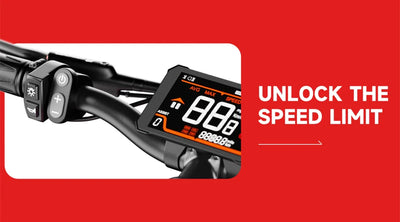
Tips & Cycling Knowledge
How to change a Class 2 e-bike to Class 3?
Welcome, e-bike enthusiasts! Ever wondered how to fine-tune your ride for the perfect balance of effort and speed? One of the most impactful adjustments you can make is tweaking your pedal-assist speed limit. By understanding how this setting works on different e-bike categories, you can tailor your experience to truly savor every journey, whether you're looking for a leisurely cruise or a more exhilarating ride. This post will guide you through the essentials of adjusting your pedal-assist speed limit. Remember, as you explore these settings, always stay mindful of local laws and regulations to ensure a safe and responsible ride for everyone.
Ready to unleash the full potential of your electric bike? These steps will show you how to adjust your settings and unlock Class 3, allowing for pedal assist up to 28 mph.
Enter the Settings Menu: With your display screen powered on, press and hold the "+" and "-" buttons simultaneously to access the P-gear settings interface.
Navigate to P08 (Speed Limit): Briefly press the power button repeatedly until the display shows the "P08" setting. This parameter controls the maximum speed.
Enter the Password for P08:
Short-press the "+" button to enter the password input screen.
For each digit of the password 1010, use the "+" button to select the desired number and then briefly press the power button to confirm that digit. Repeat this process for all four digits (1, 0, 1, 0).
After entering the complete password, press the power button one final time to verify it.
Set the New Speed Limit: Once the password is accepted, use the "+" button to increase the speed limit to 28 mph.
Save Your Changes: To finalize the new settings, press and hold the "+" and "-" buttons simultaneously again until the display confirms the changes have been saved.
Important Considerations:
Throttle-Only Mode: Please note that when operating in throttle-only mode, the e-bike's maximum speed will remain fixed at 20 mph and cannot be altered through these settings.
Ride Safely: Always prioritize your safety on every ride. Remain attentive to your surroundings, obey all traffic regulations, and take all necessary precautions to ensure a safe and enjoyable experience.
We believe that understanding and adjusting your e-bike should be straightforward, leading to a ride that truly feels like your own. With the guidance provided, you can now confidently fine-tune your settings, always keeping safety in sync with performance for worry-free adventures on roads, trails, or cityscapes. Happy riding, and wishing you countless thrilling and safe journeys on your electric bike! 🚴🔋
Read more

Tips & Cycling Knowledge
Cadence vs Torque Sensor: What’s the Difference and Which E-Bike Fits You Best?
When shopping for an electric bike, one term you’ll often come across is “pedal assist”. But did you know that there are two main types of pedal assist sensors that can dramatically change the way your ride feels?
Let’s break it down: Cadence Sensor vs Torque Sensor — what they are, how they feel on the road, and which one suits your lifestyle best. We’ll also show how these technologies come to life in KINGBULL’s current e-bike lineup.
What Is a Cadence Sensor (a.k.a. Speed Sensor)?
A cadence sensor detects when you're pedaling and sends a signal to the motor to start assisting. It doesn’t care how hard you’re pedaling — only if you’re pedaling.
🔧 How It Works:
Measures your pedal rotation speed (RPM).
When you start pedaling, the motor kicks in after a brief delay.
The level of motor assistance is determined by the assist level you select, not by your physical effort.
🚲 How It Feels:
Predictable and consistent.
Ideal for relaxed cruising or riders who want the motor to do most of the work.
Feels more like riding a scooter with pedals.
✅ Best For:
Casual riders
Seniors
Commuters who want an easy ride without breaking a sweat
📍 KINGBULL Models with Cadence Sensors:
Literider 2.0: Lightweight, foldable, and super easy to ride—perfect for city commuters.
Hunter 2.0: Rugged and ready for adventure, this off-road beast gives you the extra power without needing to pedal hard.
What Is a Torque Sensor?
A torque sensor takes your pedal pressure into account. The harder you push the pedals, the more power the motor gives you. It’s a dynamic system that creates a more natural, intuitive riding experience.
🔧 How It Works:
Measures the force you're applying on the pedals in real time.
Motor output changes with your effort.
It’s like having a very smart riding partner who knows exactly when you need help.
🚲 How It Feels:
Smooth and responsive.
Feels like riding a traditional bike, just with a bionic boost.
Better control and balance, especially on hills or in traffic.
✅ Best For:
Fitness riders who want a workout
Riders tackling varied terrain or hills
Anyone who wants the most natural ride feel
📍 KINGBULL Models with Torque Sensors:
Verve: A compact, foldable e-bike with a premium feel — responsive, agile, and commuter-friendly.
Jumper GO: Our high-performance e-bike for riders who want speed, control, and that high-end riding experience. Now available for pre-order with a $600 early bird discount!
🔍 Cadence vs Torque: A Side-by-Side Comparison
Feature
Cadence Sensor
Torque Sensor
Motor Response
On/Off style
Proportional to pedal force
Ride Feel
More like a scooter
Feels like a traditional bike
Best For
Easy riding, commuting
Fitness, dynamic terrain
Energy Use
Can drain battery faster
More efficient, conserves power
KINGBULL Models
Literider 2.0, Hunter 2.0
Verve, Jumper GO
So, Which One Is Right for You?
If you want a reliable, low-effort ride — something that gets you from A to B with minimal exertion — go with a cadence sensor model like the Literider 2.0 or Hunter 2.0.
But if you crave that natural, responsive ride and want to feel like your bike is truly in sync with your pedaling, the Verve or Jumper GO with torque sensors might be your perfect match.
Final Thoughts
Whether you're cruising through the city or climbing mountain trails, knowing the difference between cadence and torque sensors will help you choose the bike that feels right. At KINGBULL, we’ve designed our lineup to suit different riding styles — because every rider deserves a bike that matches their rhythm.
Ready to ride smarter? Explore our bikes now.
Read more




